Scots Pine | Pinus Sylvestris | German Pine
High quality Scots Pine woods are available in different shapes and sizes at wholesale prices.
Data sheet
| Common Name(s) | Scots Pine, Scot Pine, German Pine, Nordic Redwood, Scots Fir, Scotch Fir, Riga Pine, Norway Pine, Mongolian Pine, Red Deal, Yellow Deal |
| Scientific Name | Pinus sylvestris |
| Tree Size | 65-115 ft (20-35 m) tall, 2-3 ft (.6-1 m) trunk diameter |
| Average Dried Weight | 550 kg/m3 (34 lbs/ft3) |
| Specific Gravity (Basic, 12% MC) | 39, .55 |
| Janka Hardness | 540 lbf (2,420 N) |
| Modulus of Rupture | 12,080 lbf/in2 (83.3 MPa) |
| Elastic Modulus | 1,461,000 lbf/in2 (10.08 GPa) |
| Crushing Strength | 6,020 lbf/in2 (41.5 MPa) |
| Radial Shrinkage | 5.2% |
| Tangential Shrinkage | 8.3% |
| Volumetric Shrinkage | 13.6% |
| T/R Ratio | 1.6 |
| Color/Appearance | Heartwood is light reddish brown, demarcated sapwood is pale yellow to nearly white. |
| Grain/Texture | Grain is straight, with a medium, even texture. |
| Endgrain | Medium sized resin canals, numerous and evenly distributed, mostly solitary; earlywood to latewood transition fairly abrupt, color contrast medium; tracheid diameter medium-large. |
| Rot Resistance | Heartwood is rated as moderately durable to non-durable regarding decay resistance. Scots Pine is readily treated with preservatives and can thereafter be used in exterior applications such as posts or utility poles. |
| Workability | Scots pine is easy to work with and is a reasonably strong timber with a light weight. When treated with preservatives it is durable enough for outside use. |
| Odor | Scots Pine has a mild, resinous odor when being worked. |
| Allergies/Toxicity | Working with pine has been reported to cause allergic skin reactions and/or asthma-like symptoms in some people. |
| Pricing/Availability | Scots Pine is commonly harvested for construction lumber and pulpwood. Expect prices to be moderate within its natural growing range. |
| Sustainability | This wood species is not listed in the CITES Appendices, and is reported by the IUCN as being a species of least concern. |
| Common Uses | Utility poles, posts, boxes/crates, flooring, paper (pulpwood), and construction lumber, Flooring, Framing |
| Comments | It has an enormous distribution, spanning from Portugal in the west out to eastern Siberia. Consequently, there’s also a great amount of natural variability in terms of density, strength, and appearance because of wide range of growth conditions for tree. |
| Strength Group | Reasonably Low |
| Shrinkage | Very Low |






